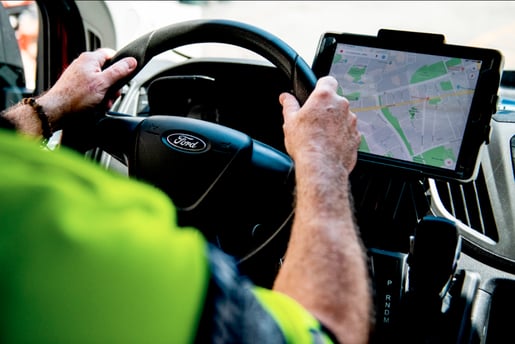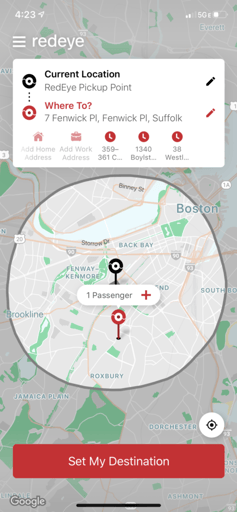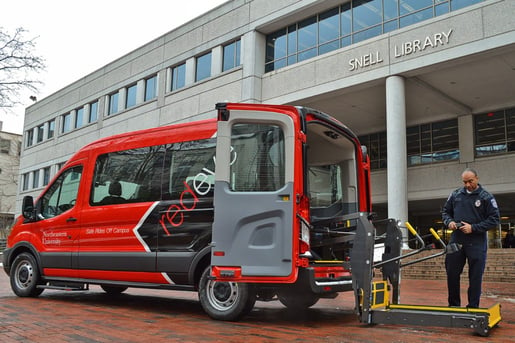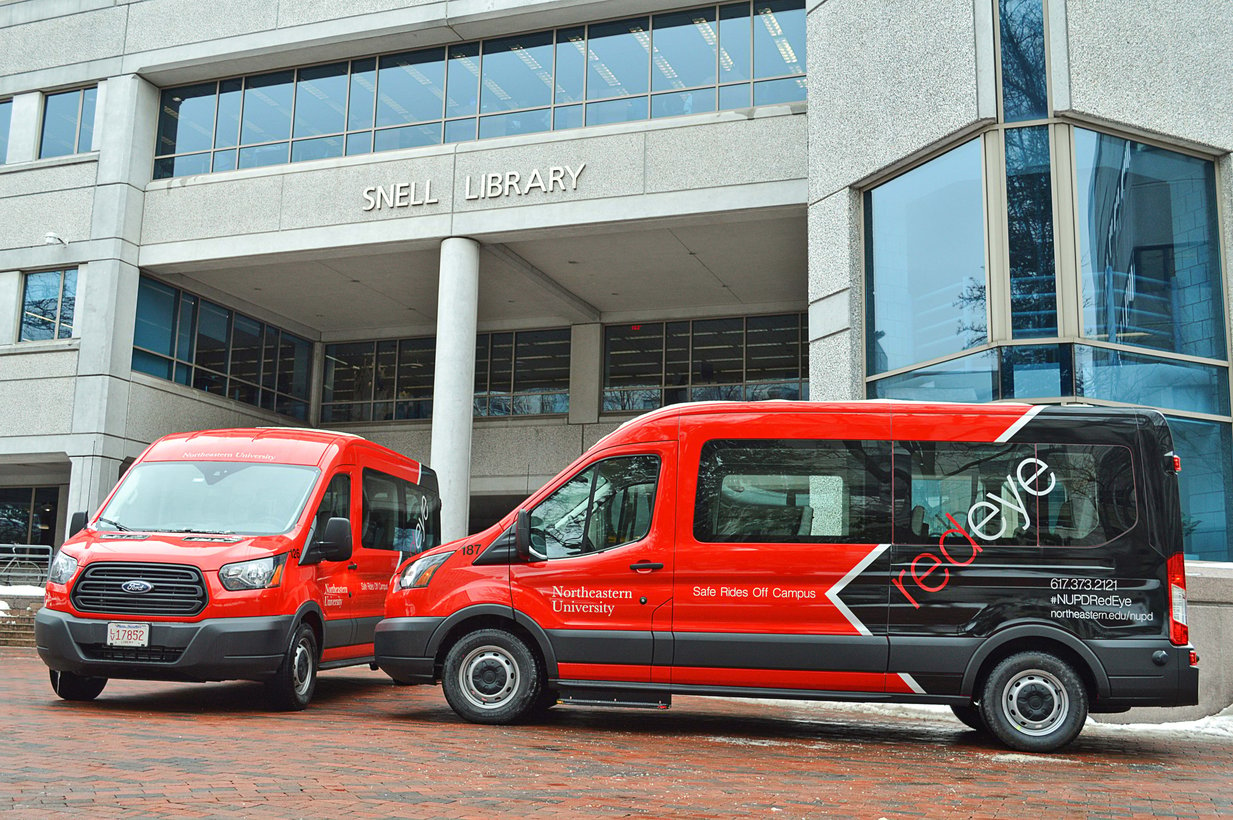It’s no secret that university students keep odd hours. Whether they’re staying up all night to cram for a final at the library, working a late shift after classes, or waking up early to put in a few more hours at the lab, college students roam campus at all hours of the evening, and ultimately, that can become a safety issue.
That’s why many universities provide a range of ways to keep students safe as they move around, from key cards to student IDs. In addition, a number of others have instituted campus-run student safety shuttles, which pick up students who were studying late at the library, attending an event at the student center, or even need a safe ride home from a weekend house party.
But these safe-ride programs have seen mixed success in how well they’ve been adopted and used by students. Generally, securing a ride on one of these shuttles entails calling an operator, stating a location, and waiting for a driver — sometimes for up to 45 minutes or an hour. Students often become frustrated and end up walking home by themselves in the dark, sometimes while inebriated — exactly what shuttles are intended to prevent.
Other students call a taxi or ride-share service, which is a better option than walking, but because these are outside services, they are no longer free and remove the student from the university’s campus security protection.
In an effort to find a more convenient way to help students arrive home safely, some universities and their campus security/police departments have explored partnering with existing ride-sharing companies to provide subsidized rides for students — a viable option, although not always free for students.
But others have been exploring a new option: building their own mobile ride-hailing service that lets students request free rides on demand.
Building Your Own On-Demand Transit Service
Some universities are partnering with software-as-a-service (SaaS) companies to build their own on-demand ride-hailing service with an app-based interface, often times using the university’s existing shuttle fleet from a previous dial-a-ride student shuttle. These partnerships create a microstransit network expressly designed for each individual campus.

Although the app is built by a third party and powered by the SaaS company’s proprietary routing technology, it’s white-labeled for the university. This allows the school to name the service and brand it according to its own standards — and, of course, run it on its own terms. A partnership of this kind creates the best of both worlds: the safety and control of a campus-run shuttle program, and the convenience and efficiency of a third-party, technology-based ride-share app.
As a university explores a partnership with a tech company for a safe ride programs, there are a few key factors to consider:
Hours of Operation
Universities can control the hours of operation based on locations and behavior of the community. That means the institution’s leaders determine things like whether the service will operate only after dark, or at all hours of the day; during holidays where the campus shuts down; and even during summer break where there may be students taking off-season classes.

Pick Up / Drop Off Zones
Just as important as the hours of operation is the area in which students can request a trip. Unlike traditional ride-hailing services that allow students to travel anywhere in the city, a university-operated shuttle can specify the zone(s) in which people can request rides. Limiting the rides to specific zones or drop-off/pick-up areas helps the university utilize the service for safe travels, and it ensures that vehicles are always available for students or staff to use.
Selecting the Fleet
The type of vehicle and the size of a university’s fleet are two important considerations for a successful shuttle deployment. If a university builds their own on-demand student shuttle network, they can select the most efficient quantity of vehicles on the road at any given time, and the capacity and style of van they think will work best to drive students to their destinations.
Hiring Trusted Drivers
It may sound obvious, but hiring the right drivers is key to student protection. That’s why universities have the power to either hire (and rigorously background-check) their own drivers, or ensure outside personnel undergo a stringent, campus-police-supported screening process.
Shared Rides are Better Rides
With a student safety shuttle, all rides are (and should be) shared. By pooling multiple students into the same vehicle, it only increases security and safety by eliminating any potential one-on-one moments with a driver. Plus, when more than one student is in a shuttle at the same time, it not only increases security, but it also makes the rides more efficient and cuts down on traffic congestion on campus (not to mention emissions).
Making it Easy
Most importantly: When it’s easier to book a ride on demand using an app, and rides arrive quickly, more students will use the service instead of walking home or calling a regular taxi — which inherently increases safety. Students will no longer have to decide between calling an operator and waiting sometimes more than 30 minutes for a ride, or just walking to their destination. By making the service as convenient to use as possible, where students are able to see the wait time, routes, and estimated times of arrival, more students will choose to take the safety shuttle than ever before.
Universities Doing Microtransit Right

Two universities in Massachusetts found success with this approach, partnering with private SaaS company Via to create their own ride-hailing apps for students to use.
Northeastern University launched its own free ride-sharing service at it’s campus in Boston, naming it the RedEye Safety Escort. The dynamically routed transit network provides students with a safe ride home from the campus library, and marks one of the first universities in North America to integrate ride hailing technology into its standard campus shuttle system.
Managed by the Northeastern University Police Department, the RedEye is available to students living within two miles of the campus center, with pickups every 30 minutes from the Snell Library Quadrangle from 7 p.m. to 6 a.m. daily.
Students use the RedEye app, available for both iOS and Android, to hail the safety escort van directly from their smartphone. The app directs passengers to a pickup point in the Snell Quad, and the app’s algorithm optimizes routing to place students headed in the same direction in the same vehicle, ensuring students arrive home safely and quickly, without lengthy detours or inconvenient fixed routes and schedules. More than 3,300 students used the service for 45,000 rides in the 2018-19 academic year alone, and Northeastern representatives say they expect an even greater uptick in use in the upcoming year.

To supplement a fixed-route campus shuttle bus, Harvard University also launched its own evening van service in August 2018 to transport faculty, staff and students safely around campus.
Individuals book the service as needed using the university’s custom-built mobile app (available for both iOS and Android). To streamline pickups, campus leadership vetted a number of safe, centralized pickup locations. Riders walk a short distance, then join their shared ride. The service operates within predetermined boundaries every night between 7 p.m. and 3 a.m. during the academic year, with reduced hours between commencement and the start of classes.
An algorithm directs the vehicle in real-time along an optimized route, keeping passenger wait times to a minimum and reducing inefficient detours that take riders out of their way. And because it’s on demand, the service can pick up passengers more quickly than a shuttle bus operating on pre-scheduled routes. The shuttle buses still run on their regular schedules, but this additional service gives students, faculty and staff an on-demand way to book quick shared trips without detours.
Some universities, such as Northwestern, also upgraded their student safety shuttles by choosing to partner with a consumer on-demand service using an existing app. The university still maintains a high-level of control over the service by choosing when students can hail a ride, what times of the school year the partnership will operate and how many vehicles they plan to dedicate to on-campus trips.
Furthermore, Northwestern worked with its partner to select drivers, with preference given to those with a demonstrated history of positive customer feedback and highest expectations for driving records. Selected drivers are also given a Northwestern-branded vehicle identifier, so students know what vehicle to watch for.
Just like the other universities who chose to develop their own, fully-branded campus safety shuttle with their own app, Northwestern expects to see a dramatic increase in the volume of students who turn to the ridesharing service to get home. Following the partnership, students will see a 38 percent increase in the total number of hours that drivers are available, utilizing an increased number of dedicated and trained drivers each night.
Having a campus-run safety shuttle is an admirable aspiration for a university, but ensuring it’s convenient and efficient is critical to student adoption. That’s why more universities are partnering with an existing on-demand service, or simply building their own. By partnering with third-party SaaS companies to build their own on-demand ride-hailing app, expressly designed with their campus in mind, universities gain a shuttle service that is customized, safe, convenient, and efficient — and students don’t need to choose between safety and speed.




